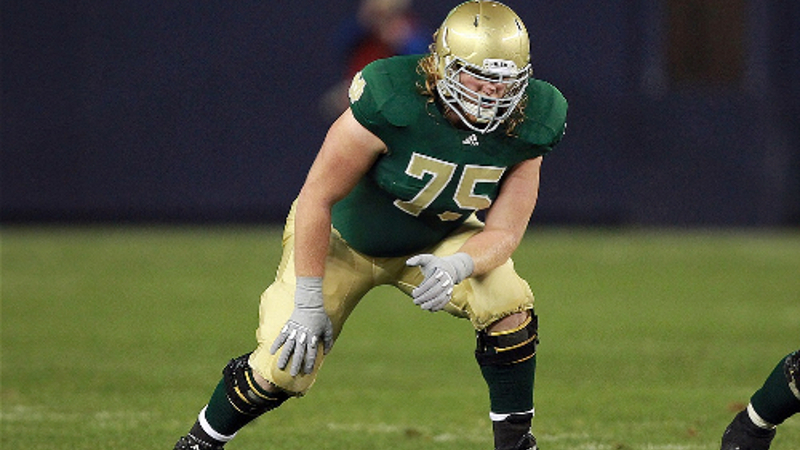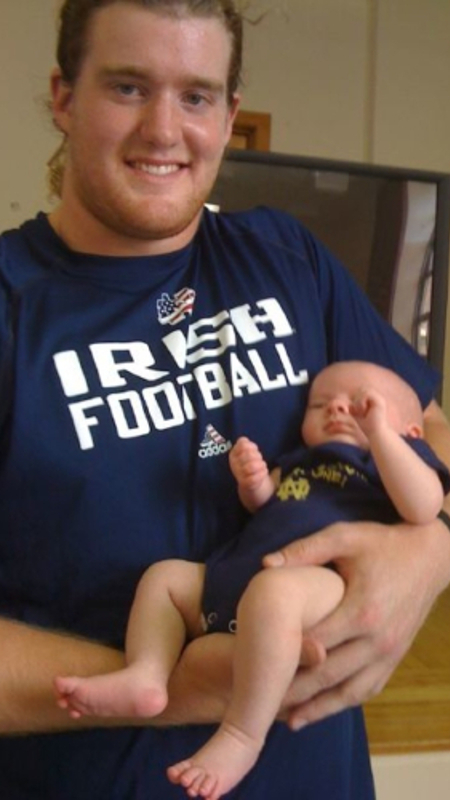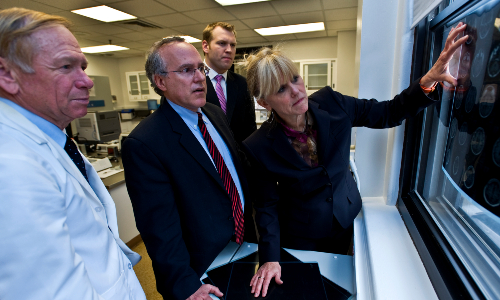Legacy Stories
Taylor Dever
Anthony Taylor Dever was a standout offensive lineman for the University of Notre Dame and was best remembered for his kindness and humility off the field. After college, his personality changed and he experienced anxiety, memory loss, paranoia, and depression. Taylor died of an accidental drug interaction in December 2020 at age 31. Taylor’s family fulfilled his wish during life of donating his brain, and researchers at the VA-BU-CLF Brain Bank diagnosed him with stage 2 (of 4) Chronic Traumatic Encephalopathy (CTE). Below, Taylor’s family share Taylor’s Legacy to provide awareness and support for those struggling with mental health and CTE.

By Taylor's family
Taylor had a beautiful way about him. His large stature was shadowed only by his giving heart. He was always there to support, to listen, and to lend a helping hand. He was quick-witted and his sense of humor was infectious. His knowledge, wisdom and insights were admirable and made most people stop and contemplate what they just heard. His smile could brighten any day. He truly cared for his family, friends, and everyone he encountered. The best stories about Taylor come from times spent with his loved ones.
Taylor was raised in Nevada City, California, a small town about 90 minutes west of Lake Tahoe in the Sierra Foothills. He loved and appreciated his community and was grateful for the support he received in return.
Taylor’s time at Nevada Union High School gave him the opportunity to develop lasting friendships. Prior to his freshman year at NUHS, Taylor had never played tackle football. He became a student of the game, both on and off the field and always strived to learn and improve. Taylor had great natural athletic ability and he excelled at everything he tried including soccer, basketball, and baseball. But football ultimately rose to the top. Nevada Union had a successful athletic program full of people who supported Taylor’s growing football career.
Taylor’s success on the field led to him being blessed with the choice of over 16 Division I scholarship offers. He ended up accepting a full athletic scholarship to the University of Notre Dame. He chose Notre Dame based on the quality of education, integrity of teammates and staff, the opportunity to contribute to a storied program, and to accomplish a lifelong dream! After graduation from NUHS in 2007, he was off to South Bend, Indiana to accomplish his next goal.

At Notre Dame, Taylor played on the offensive line, starting at tackle his last two years, and was named game day captain twice in his senior season. Taylor watched the game with a different eye, reviewing and analyzing every play. He enjoyed the camaraderie of the team working together as one unit. His college coach once noted in a press conference, “Taylor would play if not one fan showed up for the game.”

Taylor valued the bonds he created with both teammates and students at school. It didn’t matter where you were from or where you were going; he appreciated each interaction and nurtured relationships with those around him. He also showed his appreciation and compassion for others by reaching out to the local community. He participated in Notre Dame’s community outreach programs and even took the time to visit many of the organizations on his own. Taylor made many less fortunate kids’ days by giving them a hug, some words of encouragement, or a T-shirt signed by the team.


Taylor graduated in 2011 with his proudest accomplishment and the reason he chose Notre Dame: a bachelor’s degree in Marketing from the Mendoza College of Business. Upon completion of a fifth year of football in the following fall, he considered his prospects for the NFL.

After a brief stint with the Dallas Cowboys, Taylor retired from football. He then embarked on a career in sales and marketing in the tech industry. With a Notre Dame business degree under his belt and enthusiasm to embark on a new chapter in life, Taylor took advantage of the opportunities in the Bay Area and relocated to San Francisco in 2012.
Following his move, Taylor began showing signs that something was different. We started noticing gradual changes in his personality, behaviors, and his decision-making. At first, the symptoms were hard to gauge. He was living in another city and his considerate and positive spirit never wanted to bring anyone down. But by early 2017, it became clear Taylor was not himself. Over the next few months, there was a significant change in his lifestyle and his relationships. He moved back home to Nevada City that summer.
By then, Taylor’s depression, anxiety, paranoia, and short-term memory loss were prevalent. He was unable to keep a job, manage normal tasks, and maintain relationships. He turned to substances to help ease his pain, adding another layer of complexity to what he was going through. Our family tapped every resource we could to help get Taylor a diagnosis to explain the clear changes taking place. After numerous visits with various physicians and mental health professionals, scans, and MRIs, we struggled to find answers.
Not having any documented concussions during his playing time, it was difficult to make sense of the changes taking place. Over time, Taylor became suspicious his football career was a factor. He believed he was suffering from the symptoms of CTE and stated he wanted to donate his brain if the day ever came since right now, CTE can only be diagnosed post-mortem. Taylor intended to contribute to CTE research to help others in the future.
Taylor passed away in December 2020 at the age of 31 due to an accidental drug interaction. His death was the end of a years-long struggle with what we now know as stage 2 (of 4) Chronic Traumatic Encephalopathy (CTE), caused by brain trauma from repetitive hits to the head. With the clinical diagnosis from researchers at the Veterans Affairs-Boston University-Concussion Legacy Foundation (VA-BU-CLF) Brain Bank, we finally found some relief. The diagnosis explained so much of his behavior, but also raised more questions of why he developed the disease and how it turned his life upside down.
Taylor wanted to change the world. He was destined to make an impact. We are carrying on his mission with the formation of Taylor’s Tree, a nonprofit foundation aiming to provide awareness and support for mental health and suspected CTE.
Our first project with Taylor’s Tree is to support the Concussion Legacy Foundation in their efforts to raise awareness and End CTE through prevention and research. We ask you to please consider giving to CLF in Taylor's memory.
We love and miss Taylor every day!
You May Also Like

Living with suspected CTE can be difficult, but CTE is not a death sentence and it is important to maintain hope. Find out how.
Living with CTE
Although we cannot yet accurately diagnose CTE in living people, a specialist can help treat the symptoms presenting the most challenges.
CTE Treatments